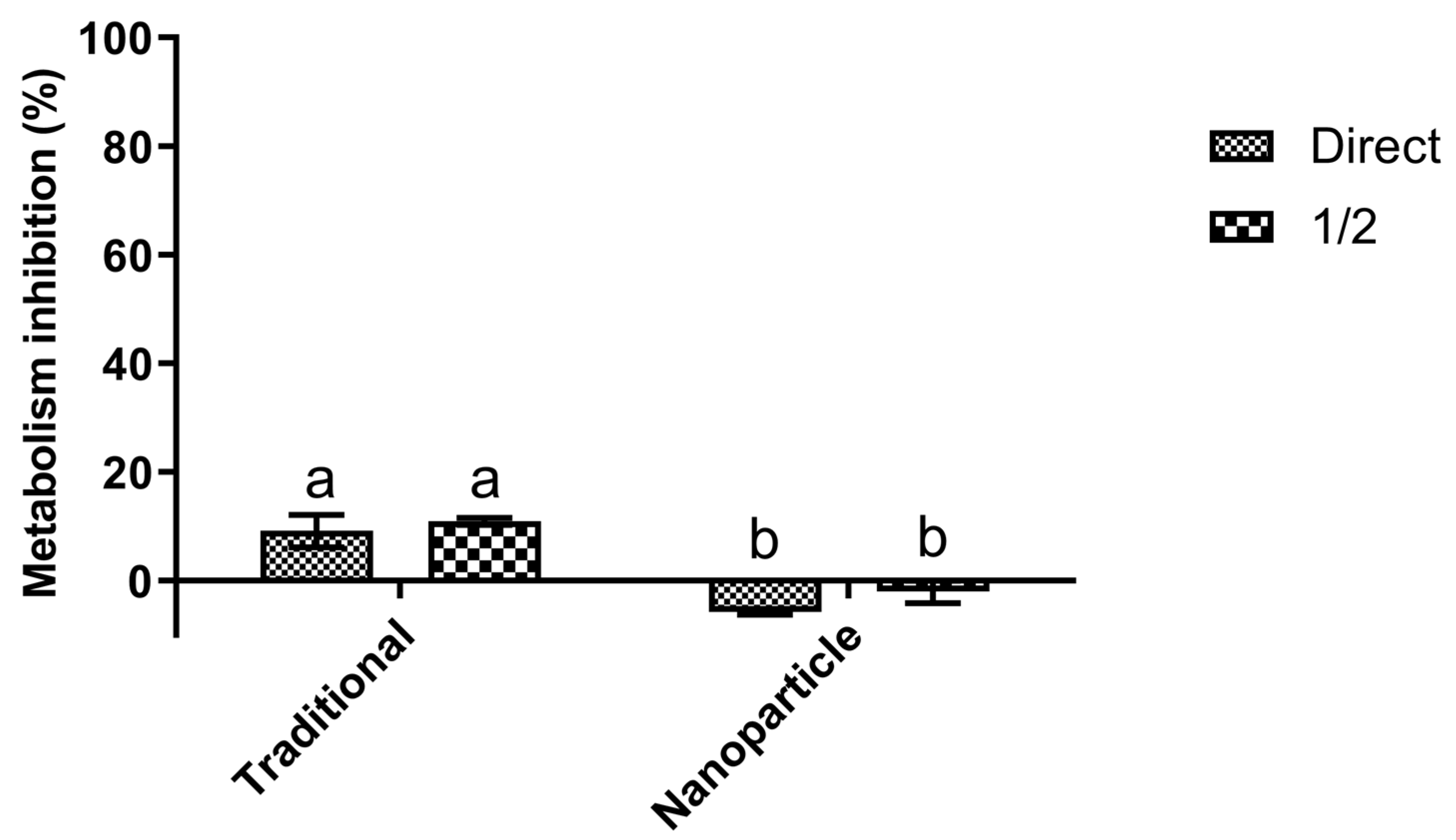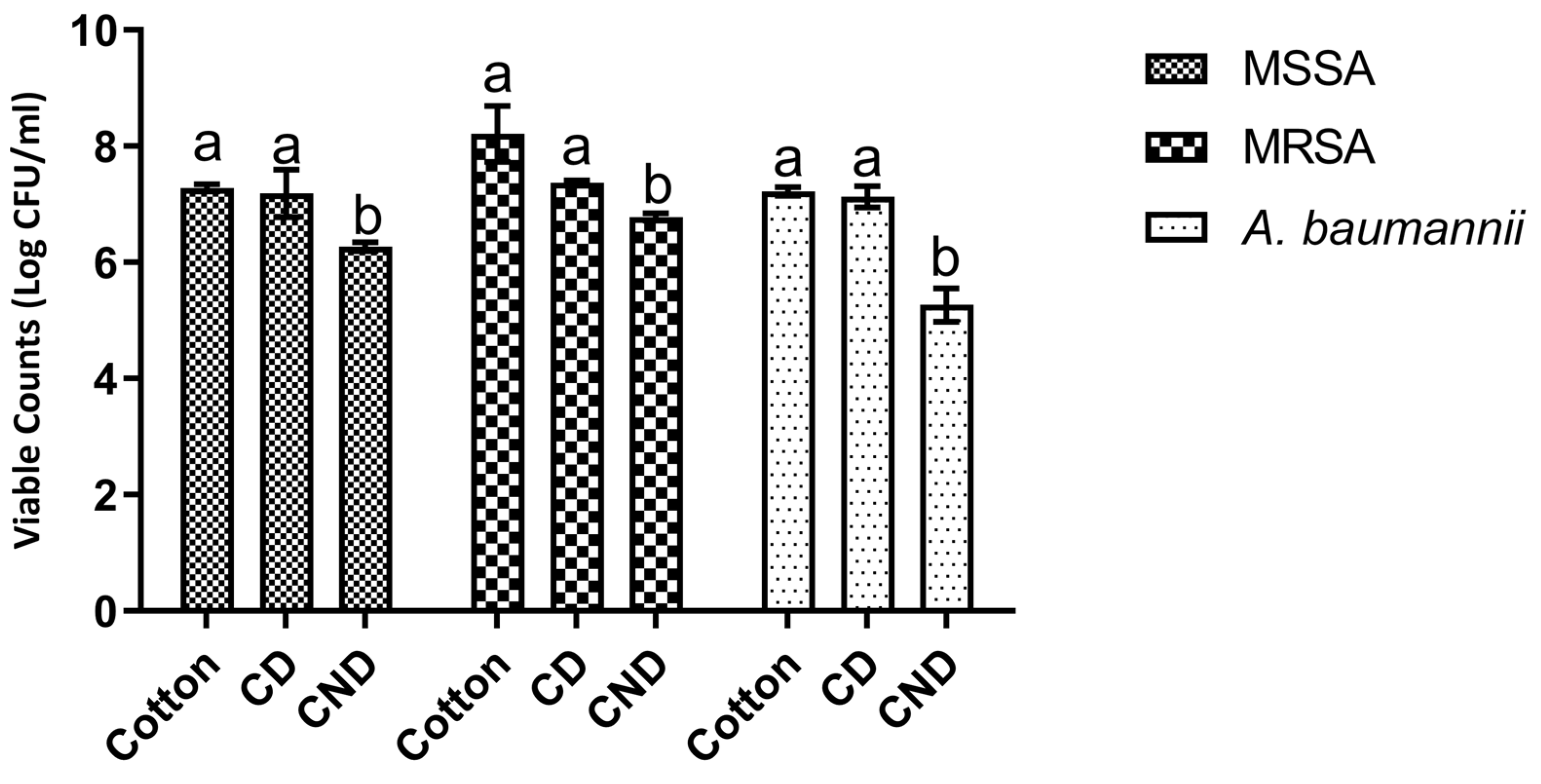Chitosan Nanoparticles as Bioactive Vehicles for Textile Dyeing: A Proof of Concept
Abstract
1. Introduction
2. Materials and Methods
2.1. Sources of Chemicals and Solutions Preparation
2.2. Nanoencapsulated Dyes Production and Textile Dying
2.3. FTIR-ATR Analysis
2.4. Surface Evaluation by Scanning Electron Microscopy
2.5. Biocompatibility Evaluation
2.5.1. Cell Line Growth Conditions
2.5.2. Biocompatibility Assays
2.6. Antimicrobial Activity
2.6.1. Microorganisms
2.6.2. Antimicrobial Activity
2.7. Statistical Analysis
3. Results
3.1. FTIR-ATR
3.2. Surface Evaluation by SEM
3.3. Biocompatibility Assays
3.4. Antimicrobial Activity Assays
4. Discussion
5. Conclusions
Author Contributions
Funding
Institutional Review Board Statement
Informed Consent Statement
Data Availability Statement
Conflicts of Interest
References
- Shahidi, S.; Wiener, J.; Ghoranneviss, M. Surface Modification Methods for Improving the Dyeability of Textile Fabrics. In Eco-Friendly Textile Dyeing and Finishing; Gunay, D.M., Ed.; InTech: London, UK, 2013. [Google Scholar]
- Hahn, T.; Bossog, L.; Hager, T.; Wunderlich, W.; Breier, R.; Stegmaier, T.; Zibek, S. Chitosan Application in Textile Processing and Fabric Coating. In Chitin and Chitosan; Wiley: Hoboken, NJ, USA, 2019; pp. 395–428. [Google Scholar]
- Berradi, M.; Hsissou, R.; Khudhair, M.; Assouag, M.; Cherkaoui, O.; El Bachiri, A.; El Harfi, A. Textile finishing dyes and their impact on aquatic environs. Heliyon 2019, 5, e02711. [Google Scholar] [CrossRef] [PubMed]
- Varadarajan, G.; Venkatachalam, P. Sustainable textile dyeing processes. Environ. Chem. Lett. 2016, 14, 113–122. [Google Scholar] [CrossRef]
- Goud, B.S.; Cha, H.L.; Koyyada, G.; Kim, J.H. Augmented Biodegradation of Textile Azo Dye Effluents by Plant Endophytes: A Sustainable, Eco-Friendly Alternative. Curr. Microbiol. 2020, 77, 3240–3255. [Google Scholar] [CrossRef] [PubMed]
- Adane, T.; Adugna, A.T.; Alemayehu, E. Textile Industry Effluent Treatment Techniques. J. Chem. 2021, 2021, 5314404. [Google Scholar] [CrossRef]
- Dong, X.; Gu, Z.; Hang, C.; Ke, G.; Jiang, L.; He, J. Study on the salt-free low-alkaline reactive cotton dyeing in high concentration of ethanol in volume. J. Clean. Prod. 2019, 226, 316–323. [Google Scholar] [CrossRef]
- Liu, L.; Mu, B.; Li, W.; Yang, Y. Cost-effective reactive dyeing using spent cooking oil for minimal discharge of dyes and salts. J. Clean. Prod. 2019, 227, 1023–1034. [Google Scholar] [CrossRef]
- Mehdi, M.; Hussain, N. Salts and water-free dyeing of cellulose nanofibers using novel green deep eutectic solvents: Isotherm, kinetics, and thermodynamic studies. J. Appl. Polym. Sci. 2022, 139, 52279. [Google Scholar] [CrossRef]
- Costa, E.M.; Silva, S.; Veiga, M.; Baptista, P.; Tavaria, F.K.; Pintado, M.E. Textile dyes loaded chitosan nanoparticles: Characterization, biocompatibility and staining capacity. Carbohydr. Polym. 2021, 251, 117120. [Google Scholar] [CrossRef]
- Li, J.; Tian, X.; Hua, T.; Fu, J.; Koo, M.; Chan, W.; Poon, T. Chitosan Natural Polymer Material for Improving Antibacterial Properties of Textiles. ACS Appl. Bio Mater. 2021, 4, 4014–4038. [Google Scholar] [CrossRef]
- Valle, J.A.B.; Valle, R.D.C.S.C.; Bierhalz, A.C.K.; Bezerra, F.M.; Hernandez, A.L.; Arias, M.J.L. Chitosan microcapsules: Methods of the production and use in the textile finishing. J. Appl. Polym. Sci. 2021, 138, 50482. [Google Scholar] [CrossRef]
- Benltoufa, S.; Miled, W. Chitosan hydrogel-coated cellulosic fabric for medical end-use: Antibacterial properties, basic mechanical and comfort properties. Carbohydr. Polym. 2020, 227, 115352. [Google Scholar] [CrossRef]
- Sheikh, J.; Bramhecha, I. Multifunctional modification of linen fabric using chitosan-based formulations. Int. J. Biol. Macromol. 2018, 118, 896–902. [Google Scholar] [CrossRef] [PubMed]
- Muzaffar, S.; Bhatti, I.A.; Zuber, M.; Bhatti, H.N.; Shahid, M. Synthesis and Characterization of Aqueous Chitosan-polyurethanes Dispersion for Textile Applications with Multipurpose Performance Profile. Fibers Polym. 2018, 19, 587–598. [Google Scholar] [CrossRef]
- Zeng, Z.W.; Wang, J.J.; Xiao, R.Z.; Xie, T.; Zhou, G.L.; Zhan, X.R.; Wang, S.L. Recent advances of chitosan nanoparticles as drug carriers. Int. J. Nanomed. 2011, 6, 765–774. [Google Scholar] [CrossRef] [PubMed]
- Korica, M.; Peršin, Z.; Zemljič, L.F.; Mihajlovski, K.; Dojčinović, B.; Trifunović, S.; Vesel, A.; Nikolić, T.; Kostić, M. Chitosan Nanoparticles Functionalized Viscose Fabrics as Potentially Durable Antibacterial Medical Textiles. Materials 2021, 14, 3762. [Google Scholar] [CrossRef]
- Maryan, A.S.; Montazer, M.; Harifi, T.; Rad, M.M. Aged-look vat dyed cotton with anti-bacterial/anti-fungal properties by treatment with nano clay and enzymes. Carbohydr. Polym. 2013, 95, 338–347. [Google Scholar] [CrossRef]
- ISO 20743; Textiles-Determination of Antibacterial Activity of Textile Products. ISO: Geneva, Switzerland, 2013; p. 32.
- Costa, E.M.; Silva, S.; Veiga, M.; Tavaria, F.; Pintado, M.M. Exploring chitosan nanoparticles as effective inhibitors of antibiotic resistant skin microorganisms–From in vitro to ex vitro testing. Carbohydr. Polym. 2018, 201, 340–346. [Google Scholar] [CrossRef]
- Hebeish, A.; Sharaf, S.; Farouk, A. Utilization of chitosan nanoparticles as a green finish in multifunctionalization of cotton textile. Int. J. Biol. Macromol. 2013, 60, 10–17. [Google Scholar] [CrossRef]
- Raza, Z.A.; Anwar, F. Fabrication of chitosan nanoparticles and multi-response optimization in their application on cotton fabric by using a Taguchi approach. Nano-Struct. Nano-Objects 2017, 10, 80–90. [Google Scholar] [CrossRef]
- Wang, M.; She, Y.; Xiao, Z.; Hu, J.; Zhou, R.; Zhang, J. The green adsorption of chitosan tripolyphosphate nanoparticles on cotton fiber surfaces. Carbohydr. Polym. 2014, 101, 812–818. [Google Scholar] [CrossRef]
- Hasanin, M.; Swielam, E.M.; Atwa, N.A.; Agwa, M.M. Novel design of bandages using cotton pads, doped with chitosan, glycogen and ZnO nanoparticles, having enhanced antimicrobial and wounds healing effects. Int. J. Biol. Macromol. 2022, 197, 121–130. [Google Scholar] [CrossRef] [PubMed]
- Wu, Y.-B.; Yu, S.-H.; Mi, F.-L.; Wu, C.-W.; Shyu, S.-S.; Peng, C.-K.; Chao, A.-C. Preparation and characterization on mechanical and antibacterial properties of chitsoan/cellulose blends. Carbohydr. Polym. 2004, 57, 435–440. [Google Scholar] [CrossRef]
- De Mesquita, J.P.; Donnici, C.L.; Pereira, F.V. Biobased Nanocomposites from Layer-by-Layer Assembly of Cellulose Nanowhiskers with Chitosan. Biomacromolecules 2010, 11, 473–480. [Google Scholar] [CrossRef] [PubMed]
- Tawfik, T.M.; El-Masry, A.M. Preparation of chitosan nanoparticles and its utilization as novel powerful enhancer for both dyeing properties and antimicrobial activity of cotton fabrics. Biointerface Res. Appl. Chem. 2021, 11, 13652–13666. [Google Scholar]
- Abdelhady, M.M. Preparation and Characterization of Chitosan/Zinc Oxide Nanoparticles for Imparting Antimicrobial and UV Protection to Cotton Fabric. Int. J. Carbohydr. Chem. 2012, 2012, 6. [Google Scholar] [CrossRef]
- Gadkari, R.R.; Ali, S.W.; Joshi, M.; Rajendran, S.; Das, A.; Alagirusamy, R. Leveraging antibacterial efficacy of silver loaded chitosan nanoparticles on layer-by-layer self-assembled coated cotton fabric. Int. J. Biol. Macromol. 2020, 162, 548–560. [Google Scholar] [CrossRef]
- Yang, X.; Wang, Z.; Zhang, Y.; Liu, W. A Biocompatible and Sustainable Anti-ultraviolet Functionalization of Cotton Fabric with Nanocellulose and Chitosan Nanocomposites. Fibers Polym. 2020, 21, 2521–2529. [Google Scholar] [CrossRef]
- Chandrasekar, S.; Vijayakumar, S.; Rajendran, R. Application of chitosan and herbal nanocomposites to develop antibacterial medical textile. Biomed. Aging Pathol. 2014, 4, 59–64. [Google Scholar] [CrossRef]
- Alminderej, F.M.; Ammar, C.; El-Ghoul, Y. Functionalization, characterization and microbiological performance of new biocompatible cellulosic dressing grafted chitosan and Suaeda fruticosa polysaccharide extract. Cellulose 2021, 28, 9821–9835. [Google Scholar] [CrossRef]
- Tseng, H.-J.; Hsu, S.-H.; Wu, M.-W.; Hsueh, T.-H.; Tu, P.-C. Nylon textiles grafted with chitosan by open air plasma and their antimicrobial effect. Fibers Polym. 2009, 10, 53–59. [Google Scholar] [CrossRef]
- Petkova, P.; Francesko, A.; Fernandes, M.M.; Mendoza, E.; Perelshtein, I.; Gedanken, A.; Tzanov, T. Sonochemical Coating of Textiles with Hybrid ZnO/Chitosan Antimicrobial Nanoparticles. ACS Appl. Mater. Interfaces 2014, 6, 1164–1172. [Google Scholar] [CrossRef] [PubMed]
- François, A.-V.; Martin, A.; Chai, F.; Neut, C.; Tabary, N.; Martel, B.; Blanchemain, N. Chitosan finishing nonwoven textiles loaded with silver and iodide for antibacterial wound dressing applications. Biomed. Mater. 2015, 10, 015023. [Google Scholar]
- Bierhalz, A.C.; Moraes, M. Composite membranes of alginate and chitosan reinforced with cotton or linen fibers incorporating epidermal growth factor. Mater. Sci. Eng. C 2017, 76, 287–294. [Google Scholar] [CrossRef] [PubMed]
- Nayak, M.C.; Isloor, A.M.; Moslehyani, A.; Ismail, N.; Ismail, A. Fabrication of novel PPSU/ZSM-5 ultrafiltration hollow fiber membranes for separation of proteins and hazardous reactive dyes. J. Taiwan Inst. Chem. Eng. 2018, 82, 342–350. [Google Scholar] [CrossRef]
- Alver, E.; Bulut, M.; Metin, A.; Çiftçi, H. One step effective removal of Congo Red in chitosan nanoparticles by encapsulation. Spectrochim. Acta Part A Mol. Biomol. Spectrosc. 2017, 171, 132–138. [Google Scholar] [CrossRef]
- Wasim, M.; Sagar, S.; Sabir, A.; Shafiq, M.; Jamil, T. Decoration of open pore network in Polyvinylidene fluoride/MWCNTs with chitosan for the removal of reactive orange 16 dye. Carbohydr. Polym. 2017, 174, 474–483. [Google Scholar] [CrossRef] [PubMed]
- Chaudhari, A.U.; Paul, D.; Dhotre, D.; Kodam, K.M. Effective biotransformation and detoxification of anthraquinone dye reactive blue 4 by using aerobic bacterial granules. Water Res. 2017, 122, 603–613. [Google Scholar] [CrossRef] [PubMed]
- Jha, P.; Jobby, R.; Desai, N. Remediation of textile azo dye acid red 114 by hairy roots of Ipomoea carnea Jacq. and assessment of degraded dye toxicity with human keratinocyte cell line. J. Hazard. Mater. 2016, 311, 158–167. [Google Scholar] [CrossRef] [PubMed]
- Jocic, D.; Vílchez, S.; Topalovic, T.; Navarro, A.; Jovancic, P.; Julià, M.R.; Erra, P. Chitosan/acid dye interactions in wool dyeing system. Carbohydr. Polym. 2005, 60, 51–59. [Google Scholar] [CrossRef]
- Luo, S.; Van Ooij, W.J. Surface modification of textile fibers for improvement of adhesion to polymeric matrices: A review. J. Adhes. Sci. Technol. 2002, 16, 1715–1735. [Google Scholar] [CrossRef]
- Song, X.; Padrão, J. 16-Testing, characterization and regulations of antimicrobial textiles. In Antimicrobial Textiles from Natural Resources; Mondal, M.I.H., Ed.; Woodhead Publishing: Sawston, UK, 2021; pp. 485–511. [Google Scholar]
- Periolatto, M.; Ferrero, F.; Vineis, C.; Rombaldoni, F. Multifunctional finishing of wool fabrics by chitosan UV-grafting: An approach. Carbohydr. Polym. 2013, 98, 624–629. [Google Scholar] [CrossRef] [PubMed]
- Bhuiyan, M.A.R.; Hossain, M.A.; Zakaria, M.; Islam, M.N.; Uddin, M.Z. Chitosan Coated Cotton Fiber: Physical and Antimicrobial Properties for Apparel Use. J. Polym. Environ. 2017, 25, 334–342. [Google Scholar] [CrossRef]
- Ali, S.W.; Rajendran, S.; Joshi, M. Synthesis and characterization of chitosan and silver loaded chitosan nanoparticles for bioactive polyester. Carbohydr. Polym. 2011, 83, 438–446. [Google Scholar] [CrossRef]
- Shahid ul, I.; Butola, B.S. Recent advances in chitosan polysaccharide and its derivatives in antimicrobial modification of textile materials. Int. J. Biol. Macromol. 2019, 121, 905–912. [Google Scholar] [CrossRef] [PubMed]
- Joshi, M.; Khanna, R.; Shekhar, R.; Jha, K. Chitosan nanocoating on cotton textile substrate using layer-by-layer self-assembly technique. J. Appl. Polym. Sci. 2011, 119, 2793–2799. [Google Scholar] [CrossRef]
- El Shafei, A.; Abou-Okeil, A. ZnO/carboxymethyl chitosan bionano-composite to impart antibacterial and UV protection for cotton fabric. Carbohydr. Polym. 2011, 83, 920–925. [Google Scholar] [CrossRef]
- Perelshtein, I.; Ruderman, E. Chitosan and chitosan-ZnO-based complex nanoparticles: Formation, characterization, and antibacterial activity. J. Mater. Chem. B 2013, 1, 1968–1976. [Google Scholar] [CrossRef] [PubMed]
- Farouk, A.; Moussa, S.; Ulbricht, M.; Textor, T. ZnO Nanoparticles-Chitosan Composite as Antibacterial Finish for Textiles. Int. J. Carbohydr. Chem. 2012, 2012, 8. [Google Scholar] [CrossRef]
- Arenas-Chávez, C.A.; de Hollanda, L.M.; Arce-Esquivel, A.A.; Alvarez-Risco, A.; Del-Aguila-Arcentales, S.; Yáñez, J.A.; Vera-Gonzales, C. Antibacterial and Antifungal Activity of Functionalized Cotton Fabric with Nanocomposite Based on Silver Nanoparticles and Carboxymethyl Chitosan. Processes 2022, 10, 1088. [Google Scholar] [CrossRef]
- Saleh, S.N.; Khaffaga, M.M.; Ali, N.M.; Hassan, M.S.; El-Naggar, A.W.M.; Rabie, A.G.M. Antibacterial functionalization of cotton and cotton/polyester fabrics applying hybrid coating of copper/chitosan nanocomposites loaded polymer blends via gamma irradiation. Int. J. Biol. Macromol. 2021, 183, 23–34. [Google Scholar] [CrossRef]




Publisher’s Note: MDPI stays neutral with regard to jurisdictional claims in published maps and institutional affiliations. |
© 2022 by the authors. Licensee MDPI, Basel, Switzerland. This article is an open access article distributed under the terms and conditions of the Creative Commons Attribution (CC BY) license (https://creativecommons.org/licenses/by/4.0/).
Share and Cite
Costa, E.M.; Silva, S.; Machado, M.; Sousa, S.C.; Tavaria, F.K.; Pintado, M. Chitosan Nanoparticles as Bioactive Vehicles for Textile Dyeing: A Proof of Concept. Polymers 2022, 14, 4821. https://doi.org/10.3390/polym14224821
Costa EM, Silva S, Machado M, Sousa SC, Tavaria FK, Pintado M. Chitosan Nanoparticles as Bioactive Vehicles for Textile Dyeing: A Proof of Concept. Polymers. 2022; 14(22):4821. https://doi.org/10.3390/polym14224821
Chicago/Turabian StyleCosta, Eduardo M., Sara Silva, Manuela Machado, Sérgio C. Sousa, Freni K. Tavaria, and Manuela Pintado. 2022. "Chitosan Nanoparticles as Bioactive Vehicles for Textile Dyeing: A Proof of Concept" Polymers 14, no. 22: 4821. https://doi.org/10.3390/polym14224821
APA StyleCosta, E. M., Silva, S., Machado, M., Sousa, S. C., Tavaria, F. K., & Pintado, M. (2022). Chitosan Nanoparticles as Bioactive Vehicles for Textile Dyeing: A Proof of Concept. Polymers, 14(22), 4821. https://doi.org/10.3390/polym14224821







